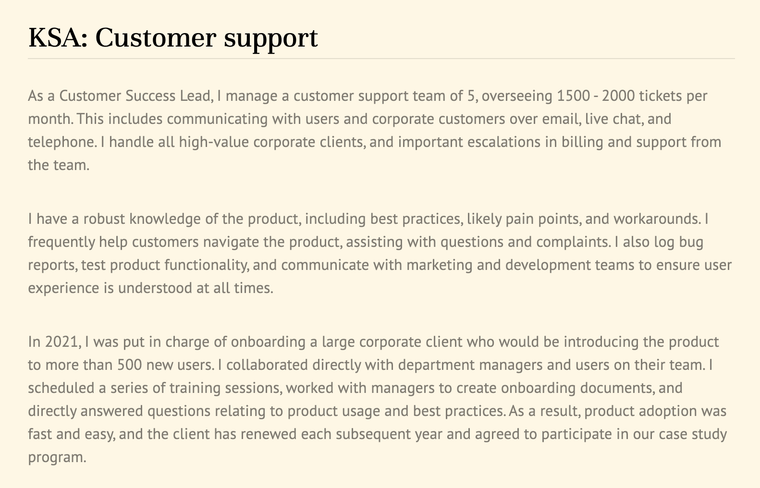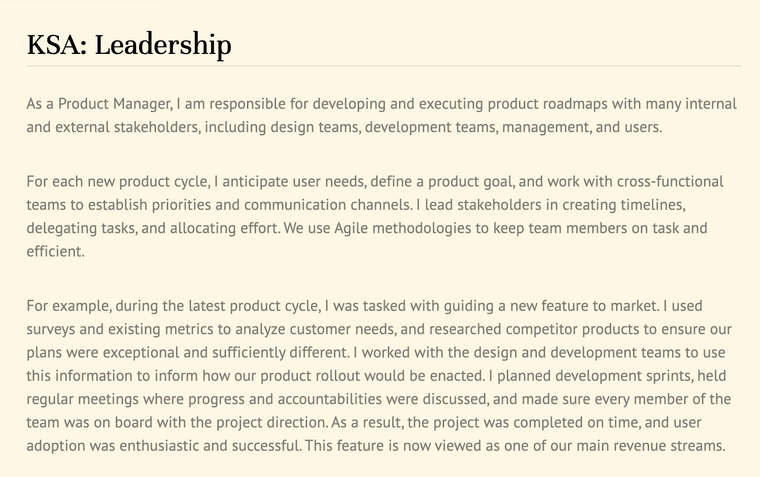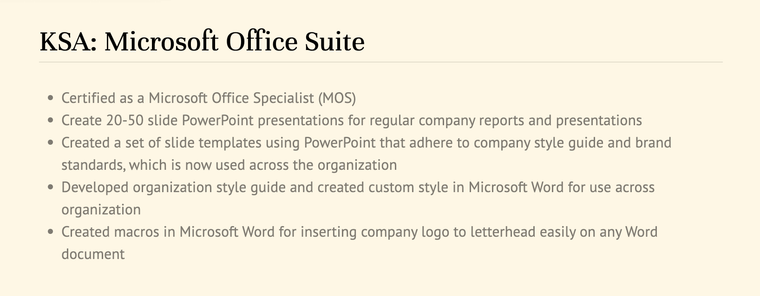
How to write a KSA Resume: what is a KSA and how do you write one?

As you conduct your job search, you may encounter a job posting that asks for a KSA resume or a KSA statement. This requirement is most common with jobs in the federal government, but other industries may ask for a KSA statement as well. Either way, it’s important to know what to do when asked for a KSA statement or KSA resume.
A KSA statement is generally a one-page essay outlining your knowledge, skills, and abilities in a particular skill area. The job application will ask for a KSA statement for a specific skill, like accounting, communicating technical ideas to a non-technical audience, or managing competing priorities. You must then write a KSA that demonstrates your knowledge, skills, and abilities in that area.
The application may ask for a specific format or a specific word count. It may also ask you to include your KSA as a part of your resume. Be sure to follow the directions carefully and fulfill all the requirements laid out in the job application.
To write a great KSA resume, it’s important to:
- Understand KSA statements
- Understand your knowledge, skills, and abilities
- Brainstorm your most impressive KSAs
- Target your KSAs to the position and to your career
What is a KSA?
KSA stands for Knowledge, Skills, and Abilities.
When hiring managers ask for a KSA, they may not be referring to a typical resume. Rather, they will be asking for a KSA statement, or asking you to describe your KSAs in a specific KSA statement somewhere within your resume.
There are three components to KSA: Knowledge, Skills, and Abilities. These three things are similar, but not the same, so it’s important to understand the differences. That said, when you write your KSA resume, you do not need to separate your KSAs into distinct sections. Instead, your single KSA statement should clearly showcase your relevant Knowledge, Skills, and Abilities clearly and effectively.
Knowledge
Your knowledge is your familiarity with the important concepts relating to your job. Knowledge might include your understanding of laws and regulations in your industry, the best practices in your field, project processes and management strategies, and standard operating procedures. The details will depend on your job and your field. Knowledge is not the hands-on tasks of the job, but the body of information you need to succeed at those tasks.
Skills
Skills are the technical capabilities specific to the job at hand. Depending on the position, this could be database design, ARC welding, inventory management, forklift operation, copyediting, and more. Having the right skills for the job is an integral part of writing a great KSA statement.
Abilities
Your abilities are the personal skills or soft skills that you bring to the job. These are transferable skills like time management, organization, conflict resolution, or problem solving. Your abilities are not necessarily directly related to the job at hand like your skills, but they are still important parts of what make you a great worker.
When do you need a KSA resume?
While your resume should always contain your relevant knowledge, skills, and abilities, you don’t need to write a KSA resume in all situations.
You should only write a KSA statement when you are specifically asked to as a part of a job application process. If a job application requires writing a KSA, it will usually ask for a KSA statement or KSA narrative. If this is the case, the KSA will be presented as a specific question or section of the application, such as:
KSA: Client management
Or
KSA: Demonstrated success leading projects with cross-functional teams
If the job application asks for a KSA, you should write your KSA statement or narrative as a paragraph or essay that meets the length requirement and submit it in the requested format. You may also be asked to include your KSA in the resume document itself.
KSA statements were once a common requirement for federal jobs, but they have fallen out of use in recent years. Organizations outside the federal government are not likely to request a KSA, but it is not unheard of. You may not encounter KSA resume requirements often, but if you do, it’s important to know what to do.
How to Write a KSA Statement for your resume
The best way to write your KSA resume will depend on the specific question asked in the job description.
The KSA question may ask you to describe a specific situation. For example, the KSA may ask you to describe your ability to manage multiple competing priorities simultaneously. If this is the case, you may want to use the STAR method to come up with a specific story that showcases your ability to manage priorities.
The STAR method is a framework for structuring anecdotes in an effective way. STAR stands for
Situation Task Action Result
This is a framework that can be used to structure KSAs (as well as answers to job interview questions and other job-related statements) effectively. Think of each aspect as a part of a story, and use the story structure to plan your statement.
First, brainstorm the knowledge, skills, and abilities that you need to highlight in your KSA resume. Then come up with a specific example of a time you demonstrated your KSAs. This example should be impressive and relevant to the job you are applying for.
Once you have chosen an example, you can use the STAR method to write your KSA statement:
Situation: Describe the context. This might include the company you were working for, the project you were working on, or a challenge you encountered.
Task: Describe the goal you had to achieve and the specific role you had in achieving it.
Action: Describe the action you took in order to overcome the obstacle (Situation) and complete the task. This section in particular should contain examples of your knowledge, skills, and abilities.
Result: Describe the results of the action you took. This might involve completing the task, improving performance, or finding a workaround to the obstacle.
The specifics of the example you choose will depend on both the role you are applying for and the exact KSA the hiring manager is asking for. It might be a KSA for a hard skill, like technical writing or database management, or it could be a soft skill, like people management or conflict resolution. The STAR method should help you formulate great answers, no matter what the question is looking for.
If the KSA requirement is more general, you may want to format it more like a resume job description, with clear examples of your achievements throughout your previous roles. In paragraph form, describe your past roles and give specific examples of accomplishments from each role so that your knowledge, skills, and abilities are clearly shown.
When describing your accomplishments, try to use quantifiable information as much as possible. Concrete examples of measurable successes are the best way to showcase your knowledge, skills and abilities. This can include budget sizes, project sizes, team sizes, customer support scores, and more.
Further, use active language to describe your KSAs. Action verbs like spearheaded, identified, evaluated, and analyzed show that you are a competent employee who takes action and works independently.
Your KSA resume should be impressive, relevant to the position, and specific to you. You should not use any generic content that sounds exactly like the job posting. Instead, your KSA resume should have specific examples from your actual career that clearly showcase the KSAs in question.
Brainstorming your KSA resume
To brainstorm your KSA resume statement, it can help to ask yourself questions about your own career and area of expertise. Brainstorming questions might include:
- What knowledge is required to do well at my job?
- What skills are required to complete my responsibilities?
- What abilities make me great at my job?
- What laws, procedures, or concepts do I need to understand to do my job?
- What tools do I use to do my job?
- What skills do I use to manage my time?
- What abilities do I use to manage people?
- What am I responsible for at work?
- What am I accountable for at work?
- What strategies do I use to manage my team?
KSA Resume examples
The best KSA to include on your resume is the one that the job application asks for. Generally, if a KSA is required, the job application will ask for a KSA in a specific area, such as customer support, leadership, or Microsoft Office Suite. When you write your KSA resume, make sure it is specific to what is being requested.
KSA: Customer support
As a Customer Success Lead, I manage a customer support team of 5, overseeing 1500 - 2000 tickets per month. This includes communicating with users and corporate customers over email, live chat, and telephone. I handle all high-value corporate clients, and important escalations in billing and support from the team.
I have a robust knowledge of the product, including best practices, likely pain points, and workarounds. I frequently help customers navigate the product, assisting with questions and complaints. I also log bug reports, test product functionality, and communicate with marketing and development teams to ensure user experience is understood at all times.
In 2021, I was put in charge of onboarding a large corporate client who would be introducing the product to more than 500 new users. I collaborated directly with department managers and users on their team. I scheduled a series of training sessions, worked with managers to create onboarding documents, and directly answered questions relating to product usage and best practices. As a result, product adoption was fast and easy, and the client has renewed each subsequent year and agreed to participate in our case study program.

KSA: Leadership
As a Product Manager, I am responsible for developing and executing product roadmaps with many internal and external stakeholders, including design teams, development teams, management, and users.
For each new product cycle, I anticipate user needs, define a product goal, and work with cross-functional teams to establish priorities and communication channels. I lead stakeholders in creating timelines, delegating tasks, and allocating effort. We use Agile methodologies to keep team members on task and efficient.
For example, during the latest product cycle, I was tasked with guiding a new feature to market. I used surveys and existing metrics to analyze customer needs, and researched competitor products to ensure our plans were exceptional and sufficiently different. I worked with the design and development teams to use this information to inform how our product rollout would be enacted. I planned development sprints, held regular meetings where progress and accountabilities were discussed, and made sure every member of the team was on board with the project direction. As a result, the project was completed on time, and user adoption was enthusiastic and successful. This feature is now one of our main revenue streams.

KSA: Microsoft Office Suite
- Certified as a Microsoft Office Specialist (MOS)
- Create 20-50 slide PowerPoint presentations for regular company reports and presentations
- Created a set of slide templates using PowerPoint that adhere to company style guide and brand standards, which is now used across the organization
- Developed organization style guide and created custom style in Microsoft Word for use across organization
- Created macros in Microsoft Word for inserting company logo to letterhead easily on any Word document


Written By
Ben Temple
Community Success Manager & CV Writing Expert
Ben is a writer, customer success manager and CV writing expert with over 5 years of experience helping job-seekers create their best careers. He believes in the importance of a great resume summary and the power of coffee.

Want the key tips on how to get a better job? Follow our systematic approach to getting everything you want in your career and new job search.
February 12, 2022
Read Post

VP Marketing & Resume Expert

Many people have several different jobs at the same company over the course of their career. Here's how to display that information on your resume.
December 17, 2022
Read Post

Community Success Manager & CV Writing Expert

A great resume lists your achievements, not your responsibilities.
October 14, 2021
Read Post

Community Success Manager & CV Writing Expert
Copyright ©2025 Workstory Inc.